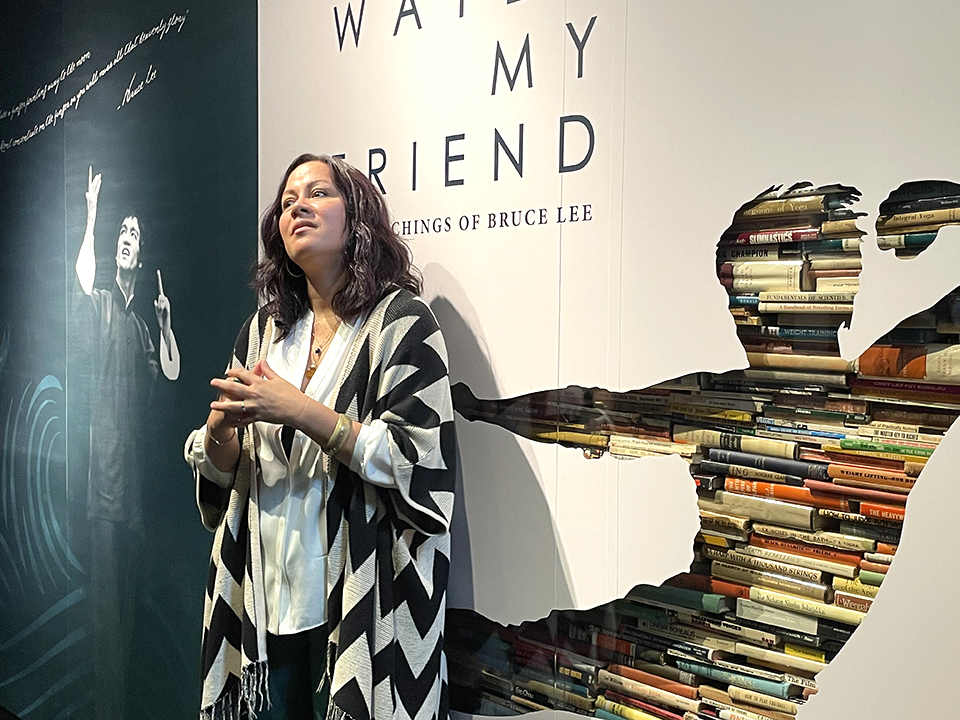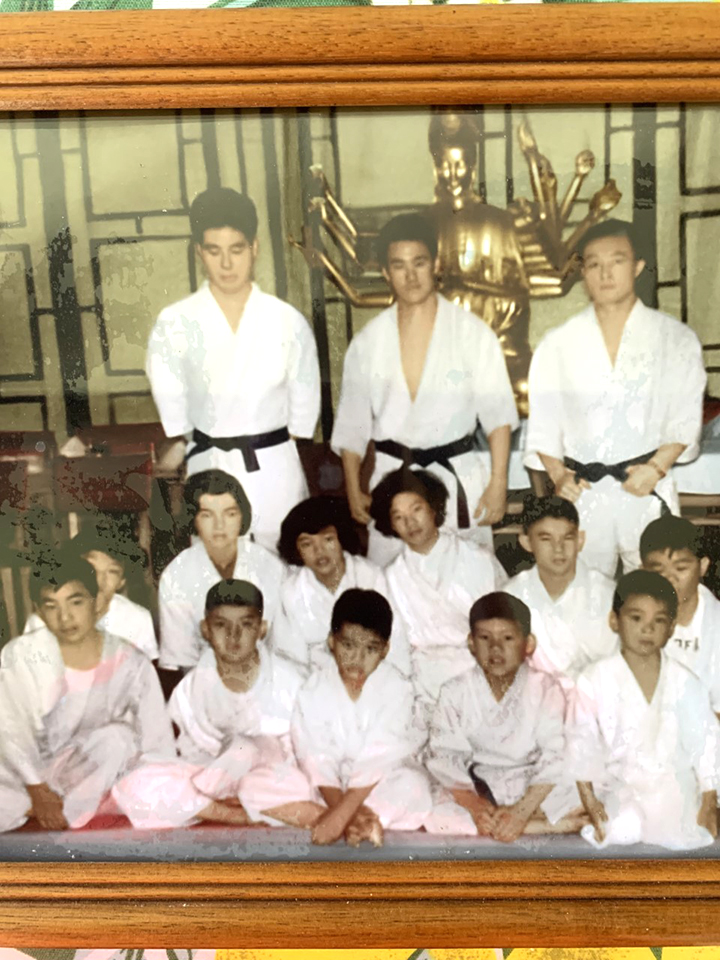By Assunta Ng
NORTHWEST ASIAN WEEKLY

Shannon Lee (Photo by Assunta Ng)
Did you know that there are more magazine covers of Bruce Lee than Marilyn Monroe?
Just Google it, and you will find that Lee graced over hundreds and hundreds of magazine covers not only in the martial arts field, but mainstream media like Rolling Stone, Time, and People. The number of Lee’s magazine covers easily exceeds thousands if you consider the multilingual martial arts and entertainment media in Asia.
And if you count the number of toys with Lee’s image and other memorabilia, you will discover that Lee’s collection is worth a lot of money. His fans span the globe, and not just in America and Asia, according to Perry Lee (no relationship to Lee), a Bruce Lee historian and collector in Seattle.

Bruce Lee (center, back row) with some Seattle judo students including Cheryl Chow (second from left, middle row), Wendee Ong (third from left, middle row), Brien Chow (front row, middle) Mark Chow (front row, far right), and Don Wong (front row, far left). (Photo from Wendee Ong)
What separated him from the other American action heroes was that he’s Asian American. Even 49 years (more than a generation) after his death, his popularity has soared.
“He (Lee) is still relevant today,” said Perry, who had met Lee in 1964. Perry was only 14 and he witnessed how Lee won his fight against a tall, big, non-Asian boxing champion.
“Nobody can match his talent. He revolutionized martial arts.”
Lee had invented a kung fu style, Jeet Kune Do (JKD), which is different from other forms of kung fu. It is also federally recognized as uniquely Asian American, while other martial arts styles had originated from Asia. An innovator, he had integrated East and West martial arts philosophy and developed his own modern brand.

In front of the Wing Luke Museum. From left: Derek Chinn, Betty Lau, Gary Locke, Shannon Lee, Wendee Ong, guest, Park Eng, Perry Lee, and Mark Chow. (Photo by Jerry Lee)
And it was during his years in Seattle, from 1959 to 1964, where he had founded kung fu schools in Chinatown as well as the University District, teaching judo and martial arts from which the inspiration for JDK materialized. There are millions of JKD students and schools all over the world.
To understand how he taught himself to apply philosophy to kung fu, the Wing Luke Asian Museum’s new Bruce Lee exhibit would shed light on his thirst for knowledge from the 2,800 books he had collected in his 32 years of life. The 230 actual books from his collection were artfully displayed through a cut-out image of Lee raising his fist and kicking high.

Shannon Lee and Joël Barraquiel Tan (Photo by Jerry Lee)
“This is [an] exciting and a beautiful follow-up into a journey of self-discovery,” said Wing’s Executive Director Joël Barraquiel Tan.
“It points to how the young Bruce Lee was shaped by this neighborhood and the community. Lots of his teachings and learnings were from here (Seattle). The ability of being in a safe nurturing community allowed him to experiment and allowed for him to be unique of who he was. That’s how he became the icon Bruce Lee.”
Shannon Lee, his daughter, was in town earlier to kick off the new exhibit.
Visiting old bookstores was one of Lee’s pastimes. A small portion of his books, about 230 books, was part of the exhibit.
“He signed every one of them,” said Shannon. “He studied, underlined, and marked on his books. He wrote notes on the margin. He was an active reader. He wanted to educate himself, and apply what he learned from the books.”
Among the piles of books he accumulated, it included philosophy, films, East and West martial arts, and different types of exercises, including boxing, weight training, yoga, and even how to play football. Why football? I suppose Lee studied football because it’s a combat sport where the violent aspect and perseverance is a major component. He might be able to apply some of its strategies.
Water was an important element of his philosophy. Through his training with his Master Ip Man, Lee would practice punching the water. He discovered that water was the “very essence of kung fu.” The exhibit’s theme was “Be Water, My Friend: The Teachings of Bruce Lee.” The exhibit illustrated how he evolved at different stages of development. It will give you a glimpse of Lee’s mind through the water element.
The exhibit has a meditative flair, different from any other Bruce Lee exhibits that exist in San Francisco and Hong Kong.
“People can experience a different side of my father than ever before,” said Shannon. “Emerge from his side of him, touch on his knowledge, philosophy, and books. How he cultivated his mind, body, and philosophy and synthesized it in his life.”
Lee’s books, a few pellets, were written in Chinese, English, and even other languages like French. He couldn’t read those languages, but he studied photos of combat books. Shannon said they were all well read as Lee underlined quotes and wrote notes in the book.
He also added his own writing, stages of self-cultivation, and you could see the process and how he gained knowledge in his whole life.
Bruce Lee in Seattle

Bruce Lee items are some of the best-selling items at the Wing. (Photo by Assunta Ng)
If you read about Bruce Lee, you would find that he had taught several Hollywood celebrities, from Steven McQueen to Chuck Norris.
But locally, his students were just as impressive, including former Governor Gary Locke, former Judge Park Eng, and Judge Mark Chow.
Born in San Francisco, Lee and his family moved back to Hong Kong in 1941. In 1959, Lee returned to the United States at the age of 19.
According to the Bruce Lee Tour organized by Wing Museum, he opened a martial arts school on South King Street, and another one on South Weller Street.
Lee’s parents were Cantonese opera and movie stars touring in different parts of the world. They were performing in San Francisco in 1940 when Lee was born. He returned to the U.S. to retain his U.S. citizenship after he turned 18. They left their son with good friends, the late Ruby and Ping Chow, who owned the Ruby Chow Restaurant. There, Lee worked as a busboy and waiter. He also lived in the attic of the restaurant.
Brien Chow, Ruby’s son, was one of Lee’s Judo students when he was 11 years old. Chow, now 71, said he never saw Lee yell at his students. Chow remembered Lee showing him tricks.
“He could move his fingers through a Batman mask so fast that you couldn’t see him doing it. That’s how good he was.” So when he hit you, you couldn’t tell where and how either.
Chow also said he practiced so hard, punching his fists over gravel, that he developed calluses.
“The most memorable moment with Bruce was when I was able to flip Bruce over my shoulder and witness Bruce flying high through the air!” said former student Wendee Ong. “I had that ‘ah ha moment’ with a lot more confidence in my skills. However, deep in my heart, I knew Bruce flew purposely high and mighty to give me a boost of confidence and a sense of success!”
Not many Seattleites know that he was an avid dancer. Lee was “a practical jokester,” said Ong. Lee taught a bunch of girls from the Seattle Chinese Girls Drill Team how to dance cha-cha at a birthday party at Ruby Chow’s Restaurant.
“He would kick his agile leg high in the air and spin around 360 degrees in two seconds flat … while returning quickly back in position to move his hips back and forth to the beat of cha cha cha! Bruce was amazing to watch,” said Ong. In 1958, Lee won the Hong Kong schools boxing tournament, and also Hong Kong’s Cha-Cha Championship, according to Wikipedia.

Bruce Lee items are some of the best-selling items at the Wing. (Photo by Assunta Ng)
Most masters can do martial arts, but not ballroom dance. They require contradictory skills: kung fu demands power punches and kicks exhibiting machismo, while cha cha is soft and elegant with sexy moves. To achieve both, reflects Lee’s talent and master of both yang and yin.
Lee would always be remembered for his mischievous grin and laughter whenever he was present, said Ong.
“Bruce was good at so many things,” said Vi Mar, 92, whom Lee called auntie in Seattle. “He’s a poet, an intellect. He liked to create verses. He learned and taught others to protect themselves. He stood up for the treatment of Chinese Americans being treated as second-class citizens.”
Through Lee’s Hollywood journey, he was given less important roles or not being cast because of his accent and fear that he wouldn’t be popular. After he went to Hong Kong, Lee proved everyone wrong. His movies were box office hits.
“Be Water, My Friend: The Teachings of Bruce Lee”
10 a.m. to 5 p.m. Wednesday – Sunday
The Wing’s interactive exhibit will be a permanent exhibit. You can also join Bruce Lee Tours, also part of Wing’s program.
Assunta can be reached at assunta@nwasianweekly.com.



